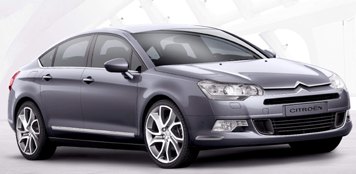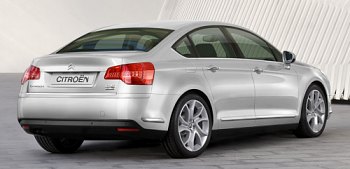|

|
French comfort combines with German
quality
|
The
outgoing C5 and its predecessor Xantia never matched the sale success
of the brilliant BX of 1980s. During these two decades Citroen forgot
how to make its mid-size cars attractive to customers. If we remember
anything of Xantia and C5, that would be probably their notorious
reliability record. A real French large car should have the following
ingredients: distinctive styling, cossetting ride, quiet cabin and
light controls. The C6 has met all these requirements, therefore no
matter how boring it appears to keen drivers it still it wins our
admiration. Now its little brother is to undergo the same test.
You might ask why we judge the new C5 according to the standard of
large French cars - isn't it a mid-sized family car ? To get the
answer, you need to look no further than the spec sheet. The new C5 is
some 160 mm longer and 90 mm wider than the old car. Its 2820 mm
wheelbase enters the same league as E-segment (executive cars) and is
considerably longer than any of its D-segment rivals bar Ford Mondeo
(which is 2850 mm). A 2.0-liter petrol C5 weighs 1521 kg while the
range-topping 2.7 V6 diesel even tips the scale at 1766 kg ! If we
don't judge it according to large car standard, what else can we do ?
We have more reasons to assume it a large car. For example, the styling
is really upmarket. The double-chevron nose, irregular-shape headlamps
and convex rear window are trademarks of Citroen, but the body profile
with high shoulder line suggests a German car. Its side profile looks
similar to Volkswagen Passat while the tail is simply Audi clone.

|
Citroen head mates with Audi tail
|
Inside, the cabin is also pretty upmarket. The quality plastics,
solidity, tight assembly and soft padding wash out our memory of the
old C5. It still falls short of Volkswagen's quality standard a little
(especially when you press the buttons), but it is compensated with the
trademark fixed-hub steering wheel (which means easy access to controls
like audio, phone, trip computer and cruise control) and the most
effective sound insulation in the class. Space-wise, the cabin isn't as
huge as the exterior dimensions suggested. It isn't as spacious as Ford
Mondeo at the back, but unless you are over 6 ft tall you won't find
the rear head and leg room tight.
The new C5 is built on the same platform as C6 and Peugeot 407,
therefore all three cars are produced in the Rennes plant in France.
Thanks to this relationship, it has a choice of conventional steel
spring suspensions (from Peugeot 407) and Citroen's traditional
hydropneumatic adaptive suspensions called Hydractive 3 Plus. If you
have followed AutoZine since the days of XM and Xantia, I suppose you
won't need more explanation on how the Hydractive suspension works. If
not, you may find more info from AutoZine Technical School. In short,
the Hydractive suspension replaces conventional springs and dampers
with a sphere containing both air and fluid. The flow of fluid can be
adjusted to alter damping hardness. Citroen C5 is unique in the
industry to offer two very different suspensions. The steel spring
suspension is standard on mainstream models and especially destined to
company car market. The Hydractive suspension is reserved for the more
expensive models (from 2.2HDI up). This should satisfy both new
customers and traditional Citroen supporters.

|
Cabin quality is marked improved
|
Comparatively, the powerplants are more conventional. There are 3
petrol engines (125hp 1.8, 140hp 2.0 and 211hp 3.0 V6), but considering
the weight of the car you had better to choose the excellent diesel
engines instead - 110 hp 1.6HDI, 136hp 2.0HDI, 170hp 2.2HDI and 204hp
2.7 V6 HDI. Regardless of price, the twin-turbo diesel V6 is of course
the first choice, as it is ultra-refined, but pairing with a mandatory
6-speed automatic gearbox reduces its performance edge over the
manual-gearbox 2.2HDI, whose sequential twin-turbo delivers linear and
responsive boost coupling with strong performance. However, both 1.6HDI
and 2.0HDI are also satisfyingly gusty, thus they will be the choices
of the majority.
On the road, the new C5 displays a handling markedly improved from the
old car, although it cannot match Ford Mondeo and Mazda 6 as a driver's
car. No, Citroen has no intention to do that - that role has been
fulfilled by Peugeot 407. Instead, it is designed to be a near-luxury
car. Cruising on highway, you will be amazed by its luxury-car
quietness, the supple ride and excellent general refinement. Yes, no
other cars in this class have ever achieved this level of comfort and
refinement, Mondeo included. The isolation from road textures is
especially amazing on the Hydractive suspension car, which could be
called "magic carpet". But keen drivers will prefer the more direct
feel of the steel-sprung car. The latter is also a little sharper in
handling. However, even the steel-sprung car betters Mondeo and others
in ride suppleness.
So the new C5 not only has all the ingredients of a real French large
car, but also German quality. Better still, it asks for
bread-and-butter price. It certainly deserves bigger success than the
last two predecessors. If its reliability match its visual quality,
Citroen will find no difficulties to sell 150,000 units of this car
annually as it planned. |